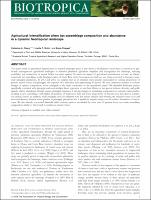| dc.contributor.author | Cleary, Katherine A. | |
| dc.contributor.author | Waits, Lisette P. | |
| dc.contributor.author | Finegan, Bryan | |
| dc.date.accessioned | 2016-10-24T23:12:56Z | |
| dc.date.available | 2016-10-24T23:12:56Z | |
| dc.date.issued | 2016 | |
| dc.identifier.uri | https://repositorio.catie.ac.cr/handle/11554/8481 | |
| dc.identifier.uri | https://doi.org/10.1111/btp.12327 | |
| dc.description.abstract | The recent trend of agricultural intensification in tropical landscapes poses a new threat to biodiversity conservation. Conversion of previously heterogeneous agricultural landscapes to intensive plantation agriculture simplifies and homogenizes the landscape, reducing availability, and connectivity of natural habitat for native species. To assess the impact of agricultural intensification on bats, we characterized the bat assemblage in the Sarapiquı region of Costa Rica, where heterogeneous land uses are being converted to intensive, largescale pineapple plantations. In 2012 and 2013, we sampled bats in 20 remnant forest patches surrounded by varying proportions of pasture, mature forest, and pineapple and captured 1821 individual bats representing 39 species. We used ordination analyses to evaluate changes in species composition, where pineapple is the main component of the agricultural matrix. We identified landscape metrics specifically correlated with pineapple and used multiple linear regression to test their effects on bat species richness, diversity, and guildspecific relative abundance. Results suggest pineapple expansion is driving changes in assemblage composition in remnant forest patches,
resulting in new assemblages with higher proportions of frugivorous bats and lower proportions of insectivorous bats than in continuous mature forests. In addition, while pineapple does not diminish total bat species richness and diversity, the reduced forest cover and increased distance between forest patches in pineapple plantations has a significant negative impact on the relative abundance of insectivores. We also identify a potential threshold effect whereby patches surrounded by more than 50 percent forest can retain assemblage composition similar to that found in continuous mature forest. | es_ES |
| dc.format.mimetype | pdf | |
| dc.language.iso | en | es_ES |
| dc.relation.ispartof | Biotropica | |
| dc.rights | info:eu-repo/semantics/restrictedAccess | |
| dc.subject | CHIROPTERA | |
| dc.subject | EXPLOTACION AGRICOLA INTENSIVA | |
| dc.subject | PAISAJE AGRICOLA | |
| dc.subject | BOSQUE REMANENTE | |
| dc.subject | CONSERVACION DE LA DIVERSIDAD BIOLOGICA | |
| dc.subject | UTILIZACION INTENSIVA DE LA TIERRA | |
| dc.subject | UTILIZACION EXTENSIVA DE LA TIERRA | |
| dc.subject | PLANTACIONES | |
| dc.subject | MONOCULTIVO | |
| dc.subject | PIÑA | |
| dc.subject | COSTA RICA | |
| dc.title | Agricultural intensification alters bat assemblage composition and abundance in a dynamic Neotropical landscape | es_ES |
| dc.type | Artículo | es_ES |
| dc.identifier.status | restrictedAccess | eng |


